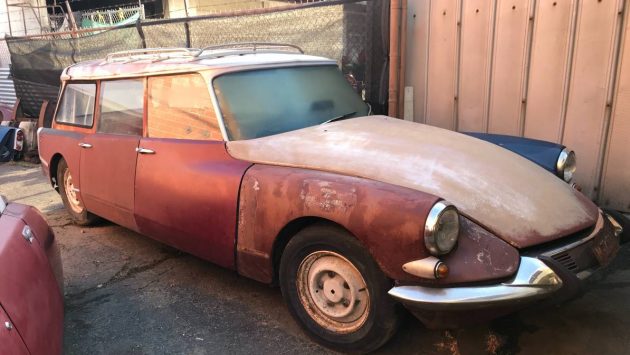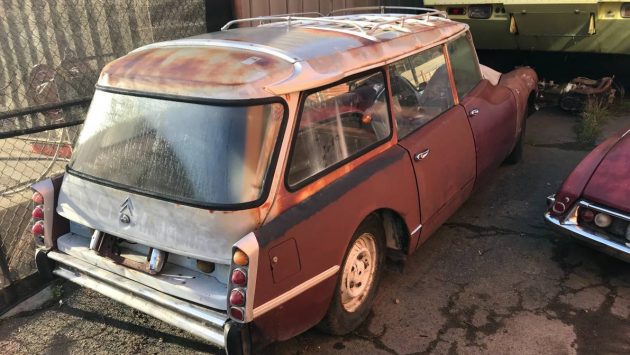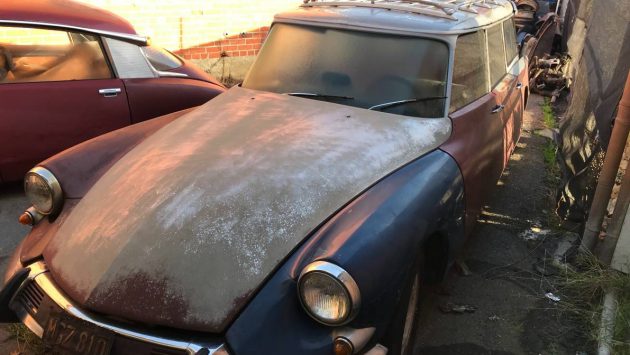Citroen’s DS cars are fascinating vehicles, overly-complex but also engineering marvels. Their values traverse a wide range, with some pristine examples selling for six-figure prices at auction in recent years. This estate-bodied example was taken in trade for services rendered, and the seller is hoping to get what he’s owed via a list price of $3K. Find here on craigslist in San Francisco or go here if the ad disappears.
Based on the tail end of another DS in the photos, it’s safe to say the seller is at least a Citroen enthusiast. When it comes to values, the later SM seems to carry a high pricetag in most any condition, provided it’s not a completely lost cause, whereas the DS can be had cheaply even in running/driving project car form. This DS “Break,” or estate, looks to have a solid body with sun-beaten paint. The likely impossible-to-replace rear glass looks good as do the taillight lenses.
Inside, the interior remains surprisingly intact. No major tears are noted on the upholstery, although the driver’s seat has clearly undergone some level of home-brew patch work based on the custom trim on the upper section. Door pulls and window cranks are all still intact, and while the dash is weathered, it doesn’t appear to have been hacked apart to accommodate a modern stereo. The seller notes it has rust on the driver’s side floor pan and in the rear near the hatch.
Of course, paint is rough all over so any patch work that has to take place would likely be obscured by a new paint job – but if this were to remain on the West Coast, I doubt highly the next owner would do anything to distort that perfectly aged exterior. It looks to have old-school California black plates in front, giving some indication as to how long it’s been sitting – but the seller further claims to have had it running, so perhaps there’s a DS driver underneath that tired exterior.






Nice project for someone who is into the interesting and unusual (are you reading this, Scotty?). Sadly, I already have too many in the garage that I need to finish.
I’ve always been a fan of the De Esse, with its advanced-if-not-always-reliable engineering (well, it is French) and Space Age styling.
They’re fabulous things (called Safaris, the estates, aren’t they?). I remember there being one over the road from me when I was wee, and wondering why it had two registration plates on the boot; one facing back, one upwards. Now I know that it’s so’s you can open the boot too carry something huge and the previously-vertical plate’ll be visible from behind. Wonder if it’s a red or a green blood one?
Note: the six-figure prices’ll be for immaculate Chapron conversions rather than production cars.
64, so red blood…
Love these cars. If it were not 3k miles away I might bite
Interesting car. The back of it if you ignore the taillights (which look like they belong on a ’57-’58 DeSoto) looks something like the front end of a bus. And you can’t complain about visibility with all those big windows.
I prefer the DS20 and DS23 for looks with the faired in headlamps and main beam linked to the steering but this one looks very saveable. OE style seat covers are available off the web from restorers – if not in the USA then from the UK and France. Being this early the hydraulic lines might be steel – in whih case figure on replacing every one with cupro-nickels. Despite legends and rumours its not that hard. I completely replumbed ad DS23 Safari in a weekend inc. new spheres and suspension units.
These are funky cool. I would add some custom made fender skirt panels to enhance its low slung look and raise the funky factor a notch.
Wow, a French car with more than 3 lug nuts on the wheels, I’m impressed. Great cars, but it’s no Ford Falcon. I’d think you’d need 2 parts cars ( like this person has) to keep it going. I just couldn’t get past the one spoke steering wheel. Are these unibody? Otherwise, plop the body on a 4×4 S-10 chassis. HA!
I had a professor at the Univ. of New Hampshire in the 1970s who drove one of these wagons to work every day. This is the only other one I’ve ever seen. The body panels are all aluminum and extremely lightweight, but they dent very easily.
Do these have a wood dashboard? I love these cars! I keep telling myself when am I going to quit saying I love these cars and go ahead and become a owner of one? However I would like to buy one that is either original in great shape or one that has been redone!
Pete, the body panels are all steel, except the roof of the sedans is either aluminum or fiberglass. Wagons always got steel. Only the hoods on all models are aluminum but that’s a real advantage when lifting a hood that large. And it’s an aircraft-type aluminum – quite hard and not easily dented. A tubular steel frame supports it inside.
Wrong way, there’s no wood in the dashes at all. and never was. As for the actual year, I checked with the seller, and the ’64 year is wrong, as somewhere along the line the tiny paint code tag, which is always AC## – on this car AC64 – was mistaken for a VIN no. and is totally wrong. The VIN is most likely a 6-7 digit no. starting with 46 or close followed by additional numbers and is always located on an aluminum tag on the right hand upper firewall., and can be seen in the photo – right above the wiper motor. So its VIN tag is in place and of course should match the title if certain officials haven’t mucked it up. This car is definitely a ’66 or ’67, with the later 5 main 2.1 L engine and better front transaxle, driveshafts and inboard power disc brakes – a very good combination plus standard 15 in. tires vs the early series which used an oddball Michelin 165 x 400 mm tire and singlebolt wheels.
Howard, these are unibody cars and heaven forbid someone sticks a ladder chassis under it – it would RUIN the car. Way too heavy, and would totally mess up ground clearance and everything else about these cars.
And that one spoke steering wheel is an ingenious safety wheel. In a frontal impact, the driver’s body will fold the shaft while the ring bends to slide the driver’s body sidways, reducing physical damage to the driver. And because the power steering rack sits atop the front wheel drive gearbox/differential and behind the radiator, the car has to be crushed about 4 feet before any impact gets to the steering shaft – way safer than most cars steering columns.
Neil, the hydraulic lines have always been steel since the car’s introduction in 1955 – they have to be to handle 2500 psi pressures – they’re the same as any 3/16 in. brake line on every car in the world. And can be replaced by same with the proper approach. I use hardware store hydraulic fittings, but I know what I’m doing, driving these cars since 1962 to today. Cupro-nicikel is easier t owork with and now more readily available whereas Europe is way ahead of us on that score – as usual.
These are the best, most comfortable wagon in the world – I’ve carried 1000 lbs of lumber in a ’61 and the self-adjusting suspension just stiffened up to handle it and kept normal ground clearance – there’s nothing else on the planet like these cars and I’m afraid never will be, which is why I keep them running. Engines with reasonable care will go 300K miles without a ring job or bearings. same for gearboxes. The brakes are the best in the world – full power – no vacuum boost – and with a good brake accumulator, you can make 40 full power panic stops with a dead engine – try that on any other car!
One owner of an early car – about ’62 – cruised his wagon at 100 mph with his friend asleep in the front seat. The friend had no idea how fast they were going til he woke up. And the hydropneumatic suspension eats potholes for breakfast all day long. My favorite trick is suckering some punk who’s pushing me on the road into following me over speed bumps at 40 mph and watching as they bang off their ceiling while my Citroen sucks the bumps up and spits them out as tho they never existed. NO OTHER ordinary car can do that!
Thanks Ken, great info! Now, where can I get one that’s in good to very good condition?
Join the San Francisco Citroen club or the larger nat’l one based out of Toronto – which sends out the “Citroenvie” club newsletter, or come to one of the rendezous held around the States – The LA/SF area clubs meet at Cambria on the W. coast once or twice a yr, while the big meet in Saratoga NY is held on Father’s day wkend and has been going on for about 30 yrs and has a very large turnout.
Complete repair manuals are available on the web for download on all the models. The cars’ plumbing is just that – plumbing. And if you’re willing to learn a bit about plumbing, you can self-service the car. Best to talk with a very knowledgeable longtime owner to learn as you can find out about the most prevalent problems quickest that way. Suspension spheres are available from US suppliers and European sources via internet. I regas them myself with a rig I built 35 yrs ago and a standard nitrogen bottle. Seals are available from most well-stocked hydraulic supply outlets, and the green (LHM) mineral fluid cars can use standard hardware store Orings in many cases.
Thanks again Ken, info appreciated! I will look into it! I really do want one, but like I said I have to get one in really great shape because I am to old to redo myself, but would love getting involved in this great car!